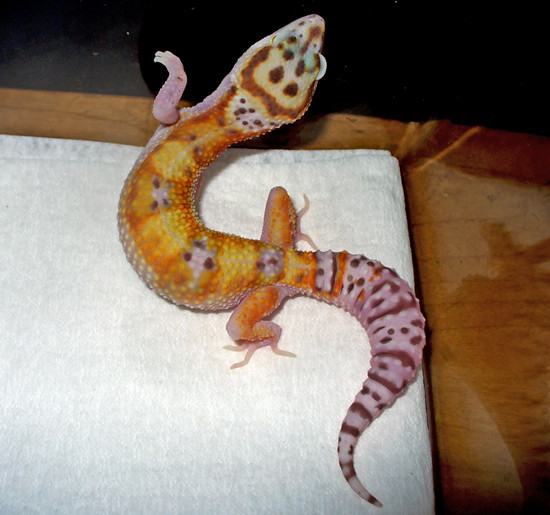5 October 2011
The first thing that is clear when talking with Jeff is that he has in-depth knowledge of, and passion for, gecko genetics. My mission for this interview was to pick his brain covering JMG Reptiles’ results in breeding the White & Yellow (W & Y) morph. The forums are rife with good information on this gene, but I also have discovered misinformation and incomplete information. So I asked Jeff.
Early on, the Europeans breeding W & Y’s pegged this morph as being a simple dominant trait. Then others offered that it might be a semi-dominant or co-dominant trait. Here in the U.S. and in Canada the top Leopard Gecko breeders proclaimed on their websites that the W & Y was, indeed, a dominant trait. JMG did; TUG did. And that’s exactly how the inheritance of this morph worked. Or did it? Jeff concurs with others that this gene enhances other morphs when crossed with them. He is most pleased with the Snow crosses they have made. Here W & Y cleans up the ground color. They are brighter and prettier than the average Snow. Although JMG hasn’t produced any Super Snows (SS’s) to date, Jeff says he has seen SS’s produced by others. His impression? They are even better looking than the single-copy Snows. The spots become fainter and there is a distinctive look to the morph.
Upon hatching, W & Y’s have weird patterns and color on the top of their heads and reduced spots on the bands. Some have the Enigma-like white nose and most develop high white sides, exhibit high contrast colors, display a white band at the nape of the neck, have distinct dorsal striping, whiter than usual tails, and reduced/faded spots. To Jeff, the W & Ys appear to include a new type of hypo, although he is still examining that aspect of this morph. He also notes that although the W & Y crosses early on appeared to be dominant in nature, he is now more convinced that the gene is a polygenetic trait. This is based upon the results he notes after hatching over 40 W & Ys. His main example is that they are similar in breeding characteristics to the JMG Hyper Xanthics. Hyper Xanthics, when out crossed, strongly influence the color of the resulting progeny; the Hyper Xanthics are a line bred polygenetic line JMG started in 2003. He also offers that, when W & Ys are crossed with normal wild-type geckos, the only effects are that the bands and spots are visually different from the normal wild-type coloration– but they did show some influence of the W & Y parent. W & Y outcrosses tend to have the black spots hypo out, if I can use that term, to become grayish or lavender in color. This is also true of morphs combined with W & Y.

Jeff doesn’t consider the W & Y morph a sister morph to Enigmas, even though the W & Y gene does have some similar effects as noted above. The enhancing effect alone should make this gene a valuable addition to any gecko breeding program. Try some! You just might like the results.
Lead photo credit: Produced and photographed by Matt Baronak of SaSobek Reptiles. Owned by Carlos Valadez of Animated Geckos.


2 Comments
Leave a ReplyOne Ping
Pingback:Gecko Time: Shannon's Quickie Interview JMG W&Y - Geckos Unlimited